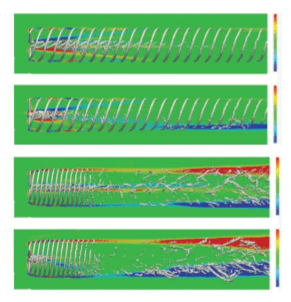A team of researchers from the University of Texas at Dallas (UT Dallas) has developed a new way to extract more power from the wind. The approach has the potential to significantly increase wind-power generation with a consequent increase in revenue. Numerical simulations performed at the Texas Advanced Computing Center (TACC) indicate potential increases of up to 6 to 7%. According to the researchers, the new method has the potential to generate $600 million in added wind power nationwide from existing wind facilities.

The turbine model shows how turbulence from the tower affects the wake downstream.
A common way to model turbulence in fluids is through large-eddy simulations. Several years ago, Associate Professor of Mechanical Engineering Stefano Leonardi, and his research team, created models that can combine physical behavior across a wide range of length scales — from 100-m diameter rotors to centimeters-thick blade tips — and accurately predict wind power using supercomputers.
“We developed a code to mimic wind turbines, taking into account the interference between the wake of the tower and the nacelle with the wake of the turbine rotor,” explains Leonardi who was also lead author on a paper describing the work.
In addition to length scales, modeling the variability of wind for a given region at a specific time is another challenge. To address this, the team added the Weather Research and Forecasting Model (WRF) to their code, a leading weather-prediction model developed at the National Center for Atmospheric Research.
“We can get a wind field from the North American Mesoscale Model on a coarse grid, use it as an input for five nested domains with progressively higher resolution (more detail) and reproduce with high fidelity the power generation of a real wind farm,” said Leonardi.
The growing power of computers lets Leonardi and his team accurately model the wind field on a wind farm and the power production of every single turbine. Testing the model results against data from a wind farm in North Texas, they saw a 90% agreement between their predictions and the turbine’s efficiency.
The problem with wind is that it does not flow smoothly in one direction. It contains turbulence and wakes which are magnified when turbines are grouped together as they are on a wind farm. Wake interactions lead to losses of up to 20% of annual production, according to the DOE. Understanding how turbulence impacts energy generation is important to adjust the behavior of the turbines in real-time to generate a maximum of power.
Using their modeling capabilities, the researchers tested control algorithms used to manage the operation of dynamic systems at wind farms. One algorithm called extremum seeking control, has been a model-free way of getting the best performance out of dynamic systems with only limited knowledge of the system.

The top view of a turbine and its wake show how it changes with rotor speed. Slowest rotation is at top and highest at the bottom
“Many thought it would not be possible to use this approach because of turbulence and the fact that it provides a situation in which turbines are changing all the time,” Leonardi said. “But we did a huge number of simulations to find a way to filter turbulence out of the control scheme. This was the major innovation.”
The extremum-seeking-control algorithm increases and then reduces the rotational speed of a spinning turbine rotor while measuring the power output, and calculating a gradient. This repeats until the controller finds an optimal operating speed.
“The important thing is that the control algorithm does not rely on a physics-based model,” Leonardi said. “There are many uncertainties in a real wind farm, so you cannot model everything. The extremum seeking control can find an optimum even when there is erosion or icing on the blades. It’s works despite uncertainties in the system.”
To test their new approach, the team ran virtual wind experiments using supercomputers at the TACC, including Stampede2 and Lonestar – two of the most powerful in the world.
“Enormous benefits come from using high-performance computing to create a virtual platform for doing analyses of proposed solutions for wind energy,” said Mario Rotea, professor of mechanical engineering at UT Dallas, and site director of the National Science Foundation-supported Wind-Energy Science, Technology and Research (WindSTAR) Industry-University Cooperative Research Center (IUCRC). “The more we can do with computers, the less we have to do with testing, which is a big part of the costs. This benefits the nation by lowering the cost of energy.”
While the application of extremum-seeking control to wind farms is yet to be field tested, the UT Dallas team already applied the method to a single turbine at the National Renewable Energy Laboratory (NREL).
“The NREL test gave us experimental data supporting the value of extremum seeking control for wind-power maximization,” said Rotea. “The experimental results show that extremum seeking control increases the power capture by 8 to 12% relative to a baseline controller.”
Given the encouraging experimental and computational results, the UT Dallas team is planning an experimental campaign involving a cluster of turbines in a wind farm.
The development of the fluid-dynamics model for wind turbines was part of an international collaboration between four U.S. institutions (Johns Hopkins University, UT Dallas, Texas Tech and Smith College) and three European institutions (Technical University of Denmark, École polytechnique fédérale de Lausanne and Katholieke Universiteit Leuven) funded by the National Science Foundation.
Filed Under: News, Projects




